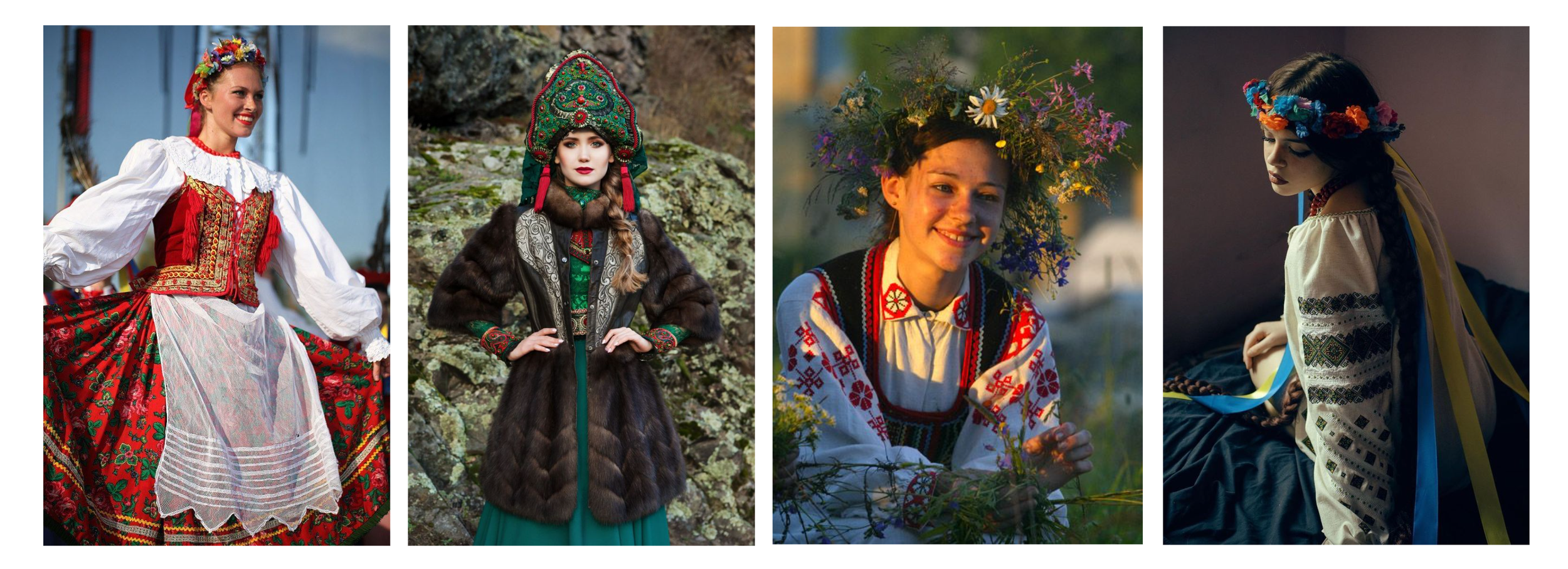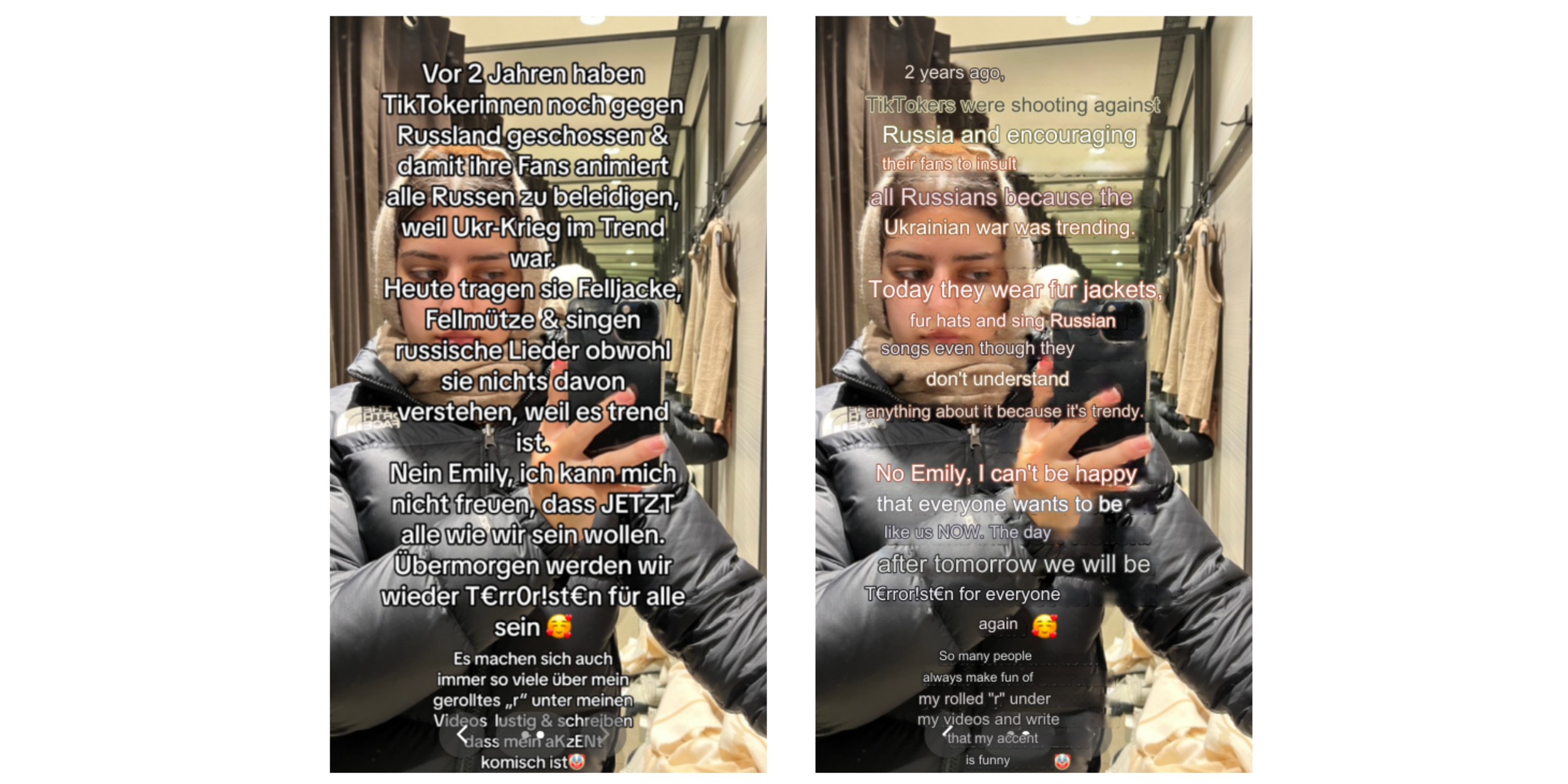The Slavic Girl Trend Explained: Fascination & Controversy on TikTok.
Y2K, Old Money Aesthetic, Barbiecore… The year 2023 has witnessed a plethora of viral trends in fashion and internet culture. TikTok, the social media powerhouse of our time, has been a major driver behind these trends. And it has kept us on our tiptoes, anticipating what’s coming next.
This winter season, a new internet phenomenon has taken reigns:
“the Slavic Girl Era”
A lot of creators and social media active people, myself included, have found this new trend both fun and controversial. Born and raised Russian, I could not pass by it. And to be honest, I generally like the trend. With a few remarks, which I’d like to discuss in this article.
I’ll explain what this trend is about, and give my honest native review, weighing its upsides and downsides through the lens of digital and cross-cultural communications. And ultimately, I’ll try to find the answers to the dubious question that has been circulating online: what is the #SlavicGirlEra– an innocent fashion trend or a careless cultural appropriation?
The Slavic Girl Aesthetic. Source: Pinterest
What is the #Slavic Girl Trend?
At the moment of publishing this article, the Slavic Girl Trend on TikTok has been viewed nearly 700 million times, and counting.
It is still unclear, who, when and how sparked the trend. But now we can see millions of people worldwide wearing traditional Slavic winter accessories and dancing to the Russian song ‘Мой Мармеладный’ (“my sweet gummy”) by Katya Lel. What really caught my attention was the incredible comeback of this old, almost-forgotten hit. This song was a chart-topper way back in 2004!
How to be a ‘Slavic Girl’ according to TikTok
The trend is built upon the so-called ‘Slavic Bimbo Girl Aesthetic’. She is a young Eastern European woman, who takes care of herself, knows her worth, and demonstrates her high status with flawless looks and luxury accessories.
Some of the key attributes include: a fur coat, ‘Boyarka’ fur hat, mittens, coupled with expensive jewelry and branded sunglasses, and to look distinctly ‘Slavic’ – a scarf with ethnic ornaments. And if you want to take your ‘Slavic’ TikTok to the next level, incorporate luxury lifestyle elements: sit in a beautiful car, drink champagne and indulge in caviar. Comical or cute?
TikTok influencers and Instagram fashionistas, people of all ages, genders and climatic zones are picking up on the ‘Russian winter’ style. Although this aesthetic has emerged ears ago, it has gained momentum only recently.
A Controversial Trend
At first glance, this seems to be just another fad and an innocent dress-up game, but on the internet, anything can be a spark in the powder keg. So, there must be a reason why the ‘Slavic Girl’ craze has received backlash from a number of TikTok users. Let’s unpack this controversial trend and figure out what is actually going on here.
Caricature & stereotypes
If you look at how Slavic women have been portrayed on the predominantly Western media, you will find a great deal of contradicting and overtly offensive stereotypes.
“Slavic women are extremely conservative, prude and old-fashioned”. From this standpoint, adherence to traditional values and customs receives a negative connotation.
“Slavic women have loose morals”, “they are dissolute or desperate for a rich sponsor”. The label of a 'mail order bride' has been so commonly attributed to Slavic women who have moved to Western countries, that it has lead to continuous public judgement and skepticism towards any female immigrants of Slavic origin.
Another common paradox is:
“Slavic nations are poor, people are low-educated, unskilled, or alcoholics”. The caricature of #gopnik (a low-class, uneducated, alcohol-addicted misdemeanant from Eastern Europe) is rooted in this misconception.
“Those rich Russians”. Phrases and terms like “the rich Russian girl style” have become buzzwords.
With that being said, I still believe that the Slavic Girl Trend does not propel any harmful stereotypes or xenophobic messages. But if we put aside the dress code attributes and take a bird-eye view, we can see that the trend in fact, doesn’t ridicule Slavic women. On the opposite, it is oriented toward the positives, such as self-care, beauty, and prosperity. This actually helps combat the entrenched negative cliché in the public eye.
Gopniks or Oligarchs’ wives? The co-existence of these contradicting stereotypes is a paradox surrounding Slavic nations.
Generalization of all Slavic nations
The trend has been criticized for throwing all Slavic cultures into the same pot.
There are more than 360 million Slavs around the world. “Slavic” is an umbrella term for very diverse nations, which can be classified into three subgroups based upon their geographic and linguistic distribution.
West Slavs (Poland, Czech Republic, Slovakia);
East Slavs (Russia, Belarus, Ukraine);
South Slavs (Croatia, Bosnia and Herzegovina, Serbia, Bulgaria, North Macedonia, Montenegro, Slovenia).
That’s not taking into account other countries with substantial populations of Slavic origin, like Germany or Denmark.
(Source: World Population Review 2023 )
Obviously, the ‘Slavic Girl aesthetic’ is not representative of all Slavic women, their lifestyles and clothing choices. However, TikTok is an entertainment platform and a 10-second clip can’t fit the whole wealth of each Slavic culture. The trend aims to celebrate the aesthetic, allure, and winter fashion that have been embraced by numerous Slavic women across different regions of Eastern and Central Europe, the Balkans, the Baltics, and Central Asia.
The “Slavic Girl” is a generalized social media character. In real life, there’s a rich diversity of unique Slavic nations.
Cancel culture
I prefer not to raise to political issues on my blog, however, the fact remains, that many people from Russia have faced hostility since the beginning of the war events. Not only does it have to do with outright insults online – it’s just the tip of an iceberg. The entire culture, from Tchaikovsky to Gagarin, has been cancelled across the board at higher structures.
Such ambivalence has prompted some social media creators to denounce the ‘Slavic Girl Trend’ as a hypocritical. The TikToker Derya writes:
"2 years ago TikTokers were shooting against Russia and encouraging their fans to insult all Russians… Today they wear fur jackets, fur hats and sing Russian songs… I can’t be happy that everyone wants to be like us now” .
There’s a grain of truth in this debate and I’d lie if I said that similar thoughts haven’t crossed my mind. Yet, I tend to believe that there’s hardly any political agenda behind the trend, and the sole reasoning is entertainment. After all, if we scan through the demographics of people who follow the trend, we’ll see that the majority are average young women and men whose interests and social content are far from political rhetoric.
@deryalisc on TikTok. Translated from German: Google.
Bullying turned admiration?
Some Slavic women on social media have expressed how they feel when they see elements of their culture objectified and turned into a trend, especially after facing mockery for it in the past. It's a fact that many Slavic people have had to deal with xenophobia and even bullying because of the stereotypes tied to their countries, languages and accents, cuisines, and traditions.
However, it is still possible to look at the issue from a different angle. The “Slavic Girl Era” trend isn't intended to poke fun at Slavic nations or cultures. Instead, it's about showing some appreciation for a small part of it – the style, beauty and self-expression of the women.
Gatekeeping: who can participate in the trend?
The "Slavic Girl Trend" has sparked a big debate on social media about who can participate in it.
Some argue that only Slavic girls should be part of this trend, claiming that "only Slavic girls can make these videos", or "the fur and the music are only for Slavic girls" or "the look suits Slavic girls best." They feel like outsiders jumping in are acting offensively and taking the spotlight away from Slavic women. This debate results in a growing opposition between women of different backgrounds.
But here's the flip side of the coin: those Slavic women calling for exclusivity should also remember that they might have joined in on trends from and for other cultures. Just think about all those TikTok Reggaeton jams and dances that went viral and spread across borders.
So, the counterargument on this point would be: there is no need to put other women down or remove any nations from participation – as long as the content doesn’t intend to insult, humiliate or ridicule a particular group.
A violation of animal rights?
The “Slavic Girl” trend has been accused of glorification of wearing fur.
While millions of animals die every year for the fur industry, it would be a shame to see a spike in thoughtless real fur consumption just because of another short-lived TikTok fad.
There’s definitely some food for thought. Yet, the accessories used by TikTokers are most often made of faux fur, and only serve as props representing traditional garments. And these are not only a status symbol. Historically, fur coats, hats and mittens have been vital for Slavic people and other Nordic nations, to survive harsh winters. In Russia alone, the temperature can drop as low as -62°C!
My Slavic stance on the trend
In this article, I’ve reviewed some common conversations around the controversial “Slavic Girl Trend” and gave some arguments and counterarguments to some of the most pressing points. It’s up to you to give those a thought and form your own opinion.
Although the "Slavic Girl" TikTok trend has ignited a conversation about cultural appropriation, it's unlikely that this trend aimed to offend or exploit Slavic culture. In fact, it has become a platform for Slavic people, to enthusiastically embrace and showcase parts of their unique culture, traditions and beauty standards. Slavic nations have stepped away from the implications of globalization and have been reclaiming their cultural identities. And in the business world, both local and international fashion brands have taken notice, releasing stunning winter collections inspired by and for Slavic women.
The trend has gone massively popular across Slavic nations, who are embracing their cultural heritage and are using it for creative inspiration.
It's important to remember that borrowing and influencing have always been part of fashion and pop culture, creating rich tapestries of creativity. And there’s no better space for cultural exchange and promoting mutual understanding than through the world of art, beauty, fashion and popular media.
In my country, there’s a common saying “a generous Russian soul” - Russians would not be Russians if they didn’t generously and eagerly share their cultural heritage with the world. So, instead of arguing about ownership, let's foster cross-cultural collaboration and create an inclusive space where diversity is welcomed and celebrated.
Thank you for making it to the end of this article!
And yes, that’s me and I’d wear this outfit before it became mainstream:)










